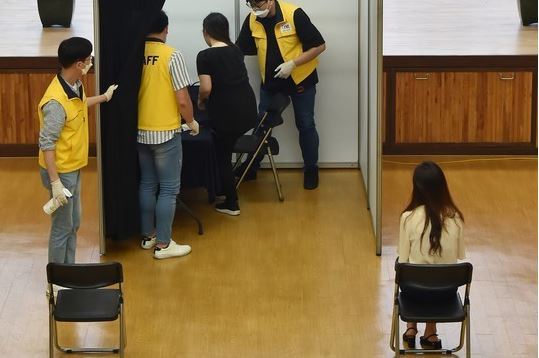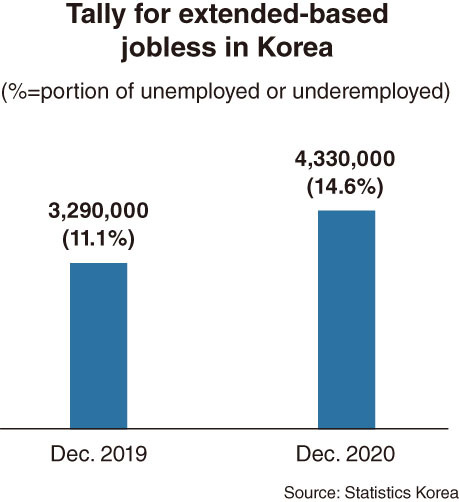 |
A jobseeker enters the booth for an interview via video at Gwangmyeong City Hall in Gyeonggi Province in June 2020 as part of a regional business recruitment amid the pandemic. (Gwangmyeong City) |
SEJONG --The number of unemployed or underemployed people in South Korea climbed to the second-highest on record in December at 14.6 percent, according to Statistics Korea.
Defined as the “extended-based” jobless rate, it refers to the percentage of the unemployed or underemployed of the economically active population under the Supplementary Index III for Employment.
The Index III regards “underemployed” people -- who work less than 36 hours a week and want to work more hours, as well as seasonal workers who are out of work for part of the year -- as unemployed.
While the nation’s official jobless rate stayed at 4.1 percent in the same month, the extended-based jobless rate suggests that the “de facto” jobless rate was higher by more than 10 percentage points than the official figure.
Under the official jobless rate of 4.1 percent, the tally for the unemployed stood at 1.13 million. But under the extended-based rate, the calculation puts the total at 4.33 million out of the economically active population of 29.7 million.
 |
(Graphic by Kim Sun-young/The Korea Herald) |
The de facto rate was the second-highest since the nation started compiling the relevant data in January 2015, following the record-high of 14.9 percent in April 2020.
The figures underscore the grave impact the COVID-19 pandemic has had on the economy, given that the de facto jobless rate stood at 11.1 percent and the tally for unemployed was 3.29 million in December 2019.
The number of those rendered de facto jobless increased by 1.04 million in only a year. The figure exceeds the population of Gyeonggi Province’s Seongnam of 939,000 and is comparable to the population of Yongin‘s 1.07 million, Goyang‘s 1.08 million and Suwon’s 1.18 million -- the four biggest cities in the nation’s most populous area, Gyeonggi.
When it comes to those aged 15-29, the extended-based unemployment rate posted 26 percent in December 2020, marking the highest in six months. The tally for youths who are unemployed and underemployed came to 1.22 million out of the economically active population of 4.71 million in the same age bracket.
This contrasts with the figure a year earlier in December 2019, when the de facto youth jobless rate and the tally stood at 20.8 percent and 1.01 million, respectively.
Meanwhile, some market observers say that the youngest-working age group had already been suffering from a tough job market before COVID-19 hit the nation.
Though the Moon Jae-in administration had pledged to create as many jobs for youths as possible, the de facto jobless for the age group between 15-29 has remained above 20 percent for 44 consecutive months since President Moon took office in May 2017.
The hiring market situation was similar for foreigners residing in Korea.
In 2016, the official unemployment rate for the expatriate population stood at 3.9 percent, according to data by the Justice Ministry and Statistics Korea.
But the figure rose from 4 percent in 2017, 4.8 percent in 2018, 5.5 percent in 2019, and then to an all-time high of 7.6 percent in 2020.
The unemployment rate for female foreigners topped the 10 percent mark for the first time in history to reach 10.6 percent as of last year.
By Kim Yon-se (
kys@heraldcorp.com)







![[Herald Interview] 'Trump will use tariffs as first line of defense for American manufacturing'](http://res.heraldm.com/phpwas/restmb_idxmake.php?idx=644&simg=/content/image/2024/11/26/20241126050017_0.jpg)
![[Exclusive] Hyundai Mobis eyes closer ties with BYD](http://res.heraldm.com/phpwas/restmb_idxmake.php?idx=644&simg=/content/image/2024/11/25/20241125050044_0.jpg)
![[Herald Review] 'Gangnam B-Side' combines social realism with masterful suspense, performance](http://res.heraldm.com/phpwas/restmb_idxmake.php?idx=644&simg=/content/image/2024/11/25/20241125050072_0.jpg)